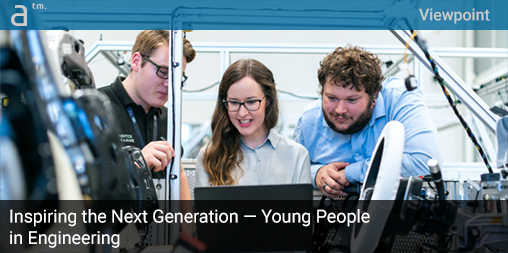THE FUTURE OF ENGINEERING HAS NEVER been more important. According to a report by the Institute of Engineering and Technology, the UK science, technology, engineering, and mathematics (STEM) sectors are experiencing a shortage of 173,000 workers, and 49% of engineering businesses are struggling to recruit skilled workers. Therefore, as the technological world continues to evolve and advance, the government strives to prioritize STEM education within primary and secondary schools.
This article will explore the ways that the UK is encouraging young people into engineering careers, from stimulating interest at a young age to creating an inclusive space for underrepresented groups in STEM and equipping students with transferable skills they will use for life.
Stimulating STEM Education Early
Many organizations are encouraging STEM learning within primary education. A continuing professional development (CPD) program, STEM learning supports primary school teachers in its endeavor to inspire the next generation of engineers. It offers regional and remote courses, bursaries, and other online materials. The Institute of Engineering and Technology also offers free material for children between 5 and 11 years of age, such as lesson plans and education videos. This equips teachers with the tools to inspire the next generation.

Efforts to make STEM studies and careers more inclusive are helping to lead girls and underrepresented groups into engineering and science fields.
In addition to this, children can begin their STEM education outside of the classroom. To encourage this, parents can teach their children to question the world around them. Even the toys children play with can be used for this purpose. Educational toys, such as coding robots, enrich children with life skills as well as the tools to excel in STEM subjects.
STEM and Underrepresented Groups
In order to inspire the future generation of engineers, we must continue to offer educational tools to underrepresented groups. In 2021, women accounted for just 14.5% of the engineering sector. The number of girls taking STEM subjects in school is significantly lower than boys. This is apparent in A-Level technology subjects, such as computer science. In 2021, the number of A-Level students taking computer science rose from 12,428 to 13,829 across the UK. Out of these, 11,798 were boys, and 2,031 were girls. This gender gap within STEM subjects can be partly explained as a result of harmful stereotypes. According to Women In Tech, early socialization and classroom culture can deter girls away from STEM subjects, as they are traditionally portrayed as boy-dominated subjects.
The skills that young men and women will learn in these subjects can form foundational knowledge to succeed as an engineer.
Computer science and technology subjects are a great way to inspire the next generation of engineers. The skills that young men and women will learn in these subjects can form foundational knowledge to succeed as an engineer. This can lead to the cultivation of multiple skills, for example, the development of engineering software such as building design software.

Today’s building design software, such as ARUP’s Oasys Ltd.’s MassMotion Flow, brings the power of leading-edge pedestrian simulation and analysis to a wider group of architects and engineers in a more affordable product. In many ways, the gaming environment young people are already familiar with resembles the software environments that power professional software used to solve numerous engineering problems in the real world. (image: Oasys Ltd.)
Furthermore, students from low socio-economic backgrounds are less likely to choose STEM subjects in school. Research from In2ScienceUK shows that students from disadvantaged backgrounds can be 2.2 times less likely to take triple science at GCSE when compared to other students. This could be due to a number of factors, from individual student interests to counter-culture within disadvantaged youth.
To tackle this, the UK government is investing money and resources into initiatives. These schemes encourage underrepresented groups to take part in STEM education and inspire the next generation of engineers. It intends to improve the accessibility of computer science to female students at GCSE and A-Level. This corresponds with other incentives, such as the Gender Balance in Computing Programme.
Thankfully, the efforts to make engineering an inclusive space is paying off. The number of people within these underrepresented groups undergoing a degree in a STEM subject has increased. Between 2010–2020, the number of women accepted onto undergraduate courses rose by 49%, and the number of people from disadvantaged backgrounds achieving places on such courses increased by a staggering 79%. This is an encouraging sign for the future minds of engineering!
Transferable Skills from STEM
STEM education equips children and young adults with transferable skills which will aid them in their future endeavors. These skills transcend the ability to solve an equation or design a building. By highlighting the importance of these transferable skills, students will realize the value of STEM education and how it can help them in multiple careers, from business management to teaching.
Advertisement
STEM education requires students to think for themselves. Tasks often involve problem-solving, and this encourages critical thinking. This skill is highly important in STEM careers, but it is also a well-respected transferable skill. Any career involving research and development would benefit from this.
Another transferable skill students learn from STEM subjects is teamwork. Working in a team will develop their communication skills, which is vital for practically any career path. Finally, STEM education requires management skills, from overseeing a project to delegating tasks. This is particularly beneficial for careers in business, as well as any engineering role.
Overall, the UK is taking the necessary steps to encourage the younger generation into STEM careers. This can start as early as childhood, from the toys they play with to the subjects at primary school. Although STEM subjects are predominately made up of boys, more and more girls are choosing to study science, technology, engineering, and mathematics subjects, such as computer science. As STEM begins to create an inclusive space for more underrepresented groups, students will gain transferable skills that can be used within engineering and a plethora of other careers.
About the Author
Natasha Bougourd is a copywriter working with the engineering software company Oasys.




Reader Comments
Comments for this story are closed